When treating bacterial infections in your cat, understanding the appropriate dosage of amoxicillin is crucial.
Using human amoxicillin for your cat can be effective, but improper dosing can lead to serious health issues.
Knowing the correct amount based on your cat’s weight is essential to ensure their recovery while minimizing risks.
Many pet owners may consider using human medications due to convenience, but it’s important to recognize that cats metabolize drugs differently than humans.
This blog will guide you through safe practices regarding amoxicillin use in cats, including how to administer the medication properly and what side effects to watch for.
By the end of this article, you’ll have the knowledge to make informed decisions about using amoxicillin for your feline friend, ensuring they get the help they need without unnecessary complications.
Key Takeaways
- Proper dosage of amoxicillin is vital for your cat’s safety.
- Human amoxicillin can be used, but dosage must be calculated carefully.
- Awareness of potential side effects can help you monitor your cat’s health.
What Is Amoxicillin?
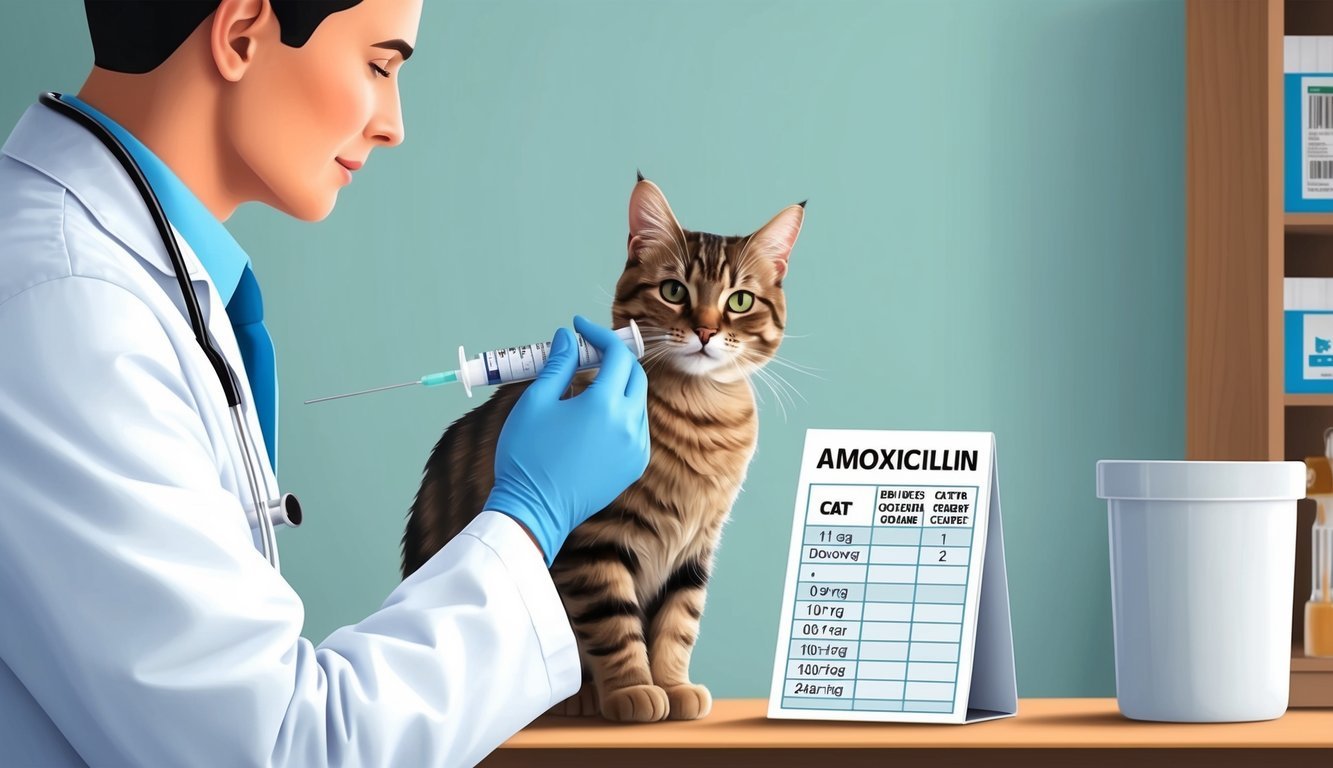
Amoxicillin is a type of antibiotic medication that belongs to the aminopenicillin class.
It is widely used in both human and veterinary medicine to treat various bacterial infections.
This broad-spectrum antibiotic is effective against a wide range of bacteria.
It targets both gram-positive and some gram-negative organisms, making it versatile for treating infections.
In your cat, amoxicillin can help with conditions like skin infections, respiratory infections, and urinary tract infections.
The medication works by inhibiting the growth of bacteria, allowing your cat’s immune system to effectively fight off the infection.
Here are some key points about amoxicillin:
- Class: Aminopenicillin
- Type: Broad-spectrum antibiotic
- Use: Treats various bacterial infections
- Administration: Typically prescribed in specific dosages for cats
Remember that human-derived amoxicillin is not suitable for cats.
The dosages are often too high and may lead to serious side effects or toxicity.
Always consult your veterinarian for the right prescription tailored to your cat’s needs.
Understanding Bacterial Infections in Cats
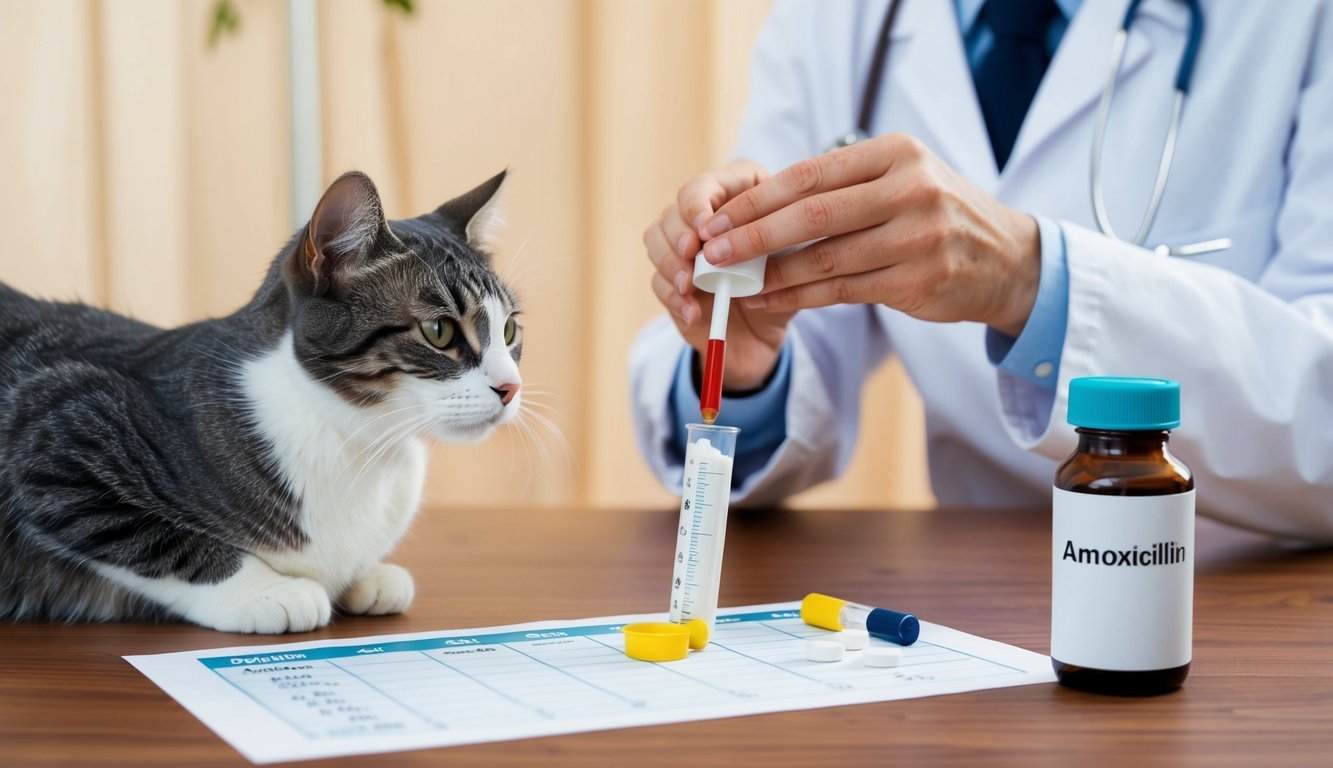
Bacterial infections can affect your cat in various ways and are often classified by the system they impact.
Recognizing the types of infections and their symptoms is vital for timely treatment.
Common Types of Bacterial Infections
Cats can experience several types of bacterial infections.
Here are the common ones:
-
Urinary Tract Infections (UTIs): Often caused by bacteria like E. coli, these infections can lead to frequent urination and discomfort.
-
Respiratory Infections: Conditions like upper respiratory infections are common, with bacteria such as staphylococcus and streptococcus often involved, causing sneezing and coughing.
-
Skin Infections: Various bacteria can lead to skin-related issues, manifesting as abscesses or inflammation.
-
Gastrointestinal Infections: These infections can cause diarrhea and vomiting, reducing your cat’s appetite.
Each type requires specific attention, as the underlying bacteria and symptoms may differ significantly.
Identifying Symptoms in Felines
Recognizing the signs of bacterial infections in your cat is essential for effective treatment.
Here are key symptoms to look out for:
-
Frequent Urination and Straining: Common in urinary tract infections. You may notice your cat making multiple trips to the litter box without much success.
-
Coughing or Sneezing: If your cat exhibits respiratory issues, this could point to a respiratory infection.
-
Vomiting and Diarrhea: An upset stomach could be indicative of a gastrointestinal infection.
-
Lethargy: Watch for decreased energy, which often accompanies many bacterial infections.
-
Skin Issues: Redness, swelling, or pus may signal a skin infection.
If you observe these symptoms, consulting your veterinarian promptly is crucial to ensure a proper diagnosis and treatment plan.
The Importance of Proper Dosage
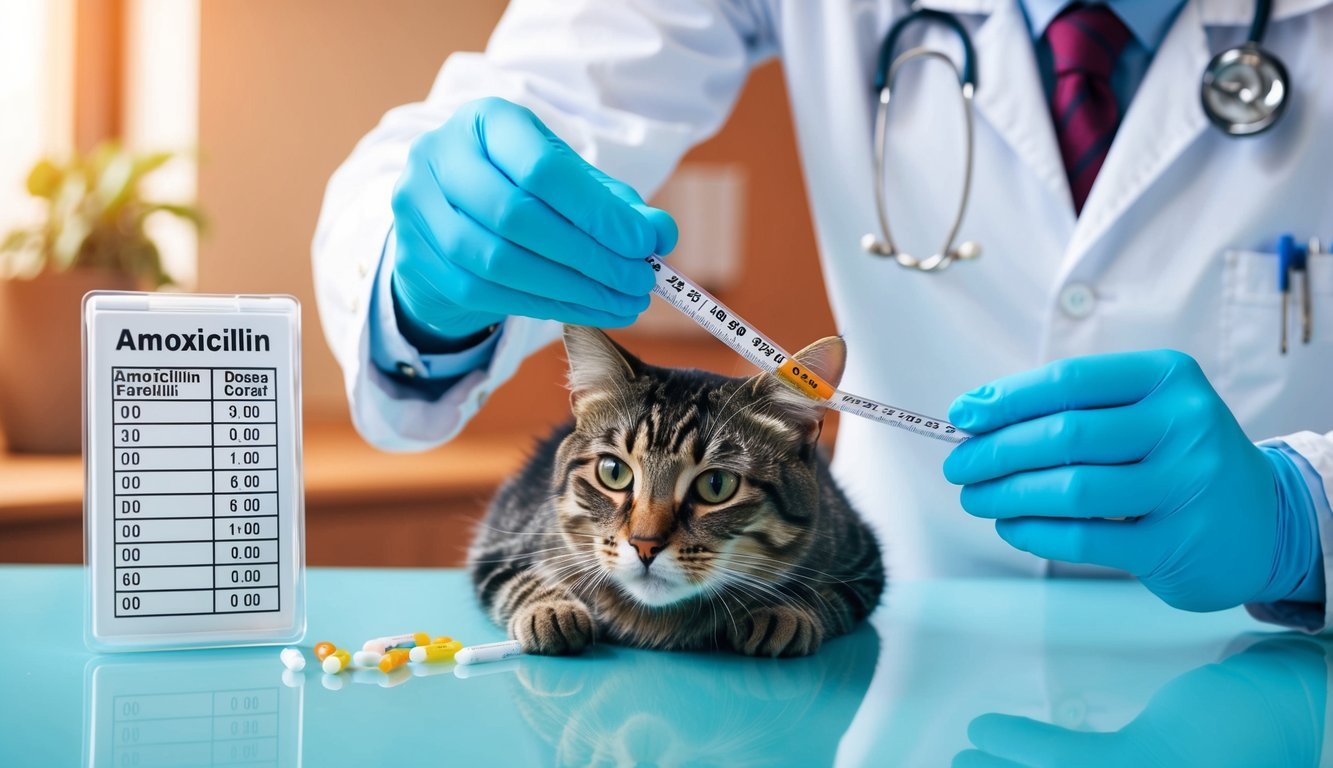
Administering the correct dosage of amoxicillin to your cat is crucial for effective treatment and minimizing side effects.
Understanding the differences in dosages for felines compared to humans, as well as how to measure doses for various forms of amoxicillin, can make a significant difference in your pet’s recovery.
Differences in Feline Dosages Compared to Humans
Cats require specific dosages of amoxicillin that differ from humans.
For cats, the typical dosage ranges from 5-10 mg per pound of body weight.
This is often given once or twice daily, depending on the severity of the infection.
In contrast, adults may take 500 mg every 8 hours or 875 mg every 12 hours.
It’s essential to consult with a veterinarian for precise dosages.
Human amoxicillin formulations often contain different inactive ingredients, which might be harmful to cats.
Always avoid using human medications without veterinary guidance.
Measuring Dosages for Different Forms of Amoxicillin
Amoxicillin comes in various formats, including tablets and liquid oral suspensions.
For tablets, the dosage depends on your cat’s weight and generally follows the 5-10 mg/lb guideline.
When administering liquid amoxicillin, the dosage can range from 2-9 ml/lb given every 12-24 hours.
Using a calibrated syringe for liquid forms ensures accurate measurement.
Be aware that dosing schedules can vary; some veterinarians may recommend doses every 8-10 hours for better efficacy.
Accurate dosing is vital, as both underdosing and overdosing can lead to serious health implications.
Always follow your veterinarian’s specific instructions.
How to Administer Amoxicillin to Cats

Administering amoxicillin to your cat can be straightforward if you understand the forms available and the best practices for each method.
Whether using tablets, capsules, or liquid form, knowing how to properly give the medication ensures your cat receives the dosage it needs for recovery.
Using Tablets and Capsules
Giving tablets or capsules can be a bit tricky since cats often resist taking them.
First, check the dosage prescribed by your veterinarian.
A typical dose is 5-10 mg per pound of body weight.
Here’s how to make it easier:
- Hide the Medication: Use a small amount of your cat’s favorite treat or a soft food to conceal the tablet.
- Direct Administration: If hiding doesn’t work, hold your cat gently but firmly. Tilt its head back slightly and place the tablet at the back of the throat.
- Encourage Swallowing: Close its mouth and gently stroke the throat to encourage swallowing. You can also offer some water with a syringe afterward if needed.
Always ensure you follow up with positive reinforcement for your cat’s cooperation during the process.
Handling Liquid Amoxicillin
Liquid amoxicillin can be an easier option for some cats.
This form is particularly useful for cats that struggle with tablets.
The typical dosage for liquid is also 5-10 mg per pound of body weight, depending on your vet’s guidance.
Follow these tips for administering liquid:
- Use a Syringe: Fill a syringe with the prescribed dose. Avoid using needles; just the syringe will work fine.
- Positioning: Position your cat in a comfortable way, ensuring it feels secure. You may want to wrap your cat in a blanket to minimize movement.
- Administer Slowly: Place the syringe towards the side of the mouth, and gently squirt the liquid. Do this slowly to prevent choking or gagging.
Afterward, reward your cat with a small treat to create a positive association with the medication.
Side Effects and Risks
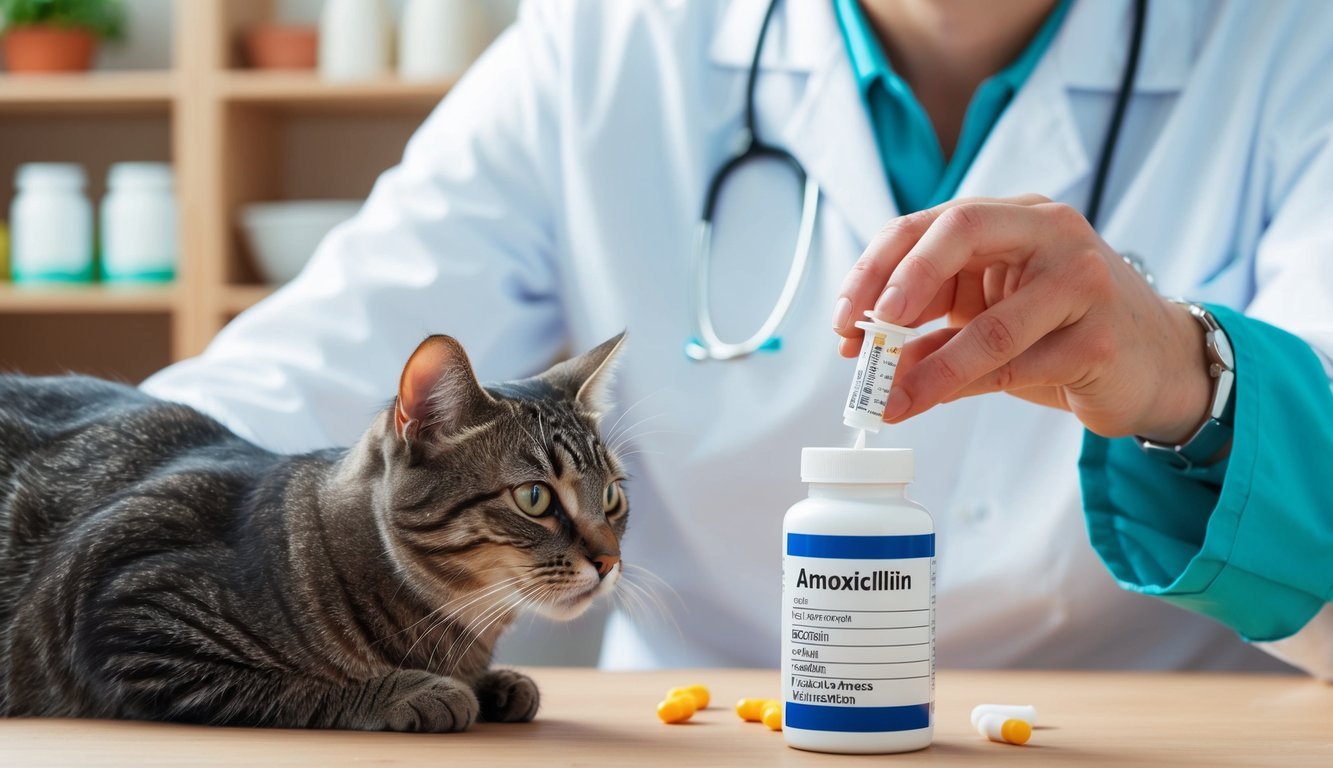
When using human amoxicillin for cats, it’s essential to be aware of the potential side effects and the risks involved.
Understanding these issues helps ensure your cat’s safety while receiving treatment, as some reactions can be serious.
Recognizing Allergic Reactions
Allergic reactions are a critical concern when giving amoxicillin to your cat.
Signs may include increased itching, swelling, or difficulty breathing.
In some cases, cats develop hives or skin rashes.
If you notice these symptoms, you should act quickly, as severe allergic reactions can lead to anaphylaxis.
Always observe how your cat reacts right after administering the medication.
If an allergic reaction occurs, discontinue use immediately and contact your veterinarian.
Managing Common Side Effects
Common side effects of amoxicillin in cats often involve gastrointestinal upset.
You might see symptoms like nausea, vomiting, or diarrhea.
These issues can typically be managed by adjusting the dosage or frequency.
Providing your cat with a small amount of food before giving the medication can help reduce these effects.
It’s important to monitor your cat closely, as persistent gastrointestinal distress may require a visit to the vet.
Remember to avoid using human formulations unless specifically prescribed, as they may contain ingredients harmful to cats.
When to Contact a Veterinarian
It’s crucial to know when to contact your veterinarian while your cat is on amoxicillin.
If your cat displays severe side effects, such as prolonged vomiting, lethargy, or signs of liver damage (yellowing of the skin or eyes), seek immediate assistance.
Your vet may need to adjust the dosage or switch to a different medication.
Additionally, if you observe any unusual behavior or worsening of symptoms, don’t hesitate to call for advice.
Prompt action can make a significant difference in your cat’s health.
Special Considerations
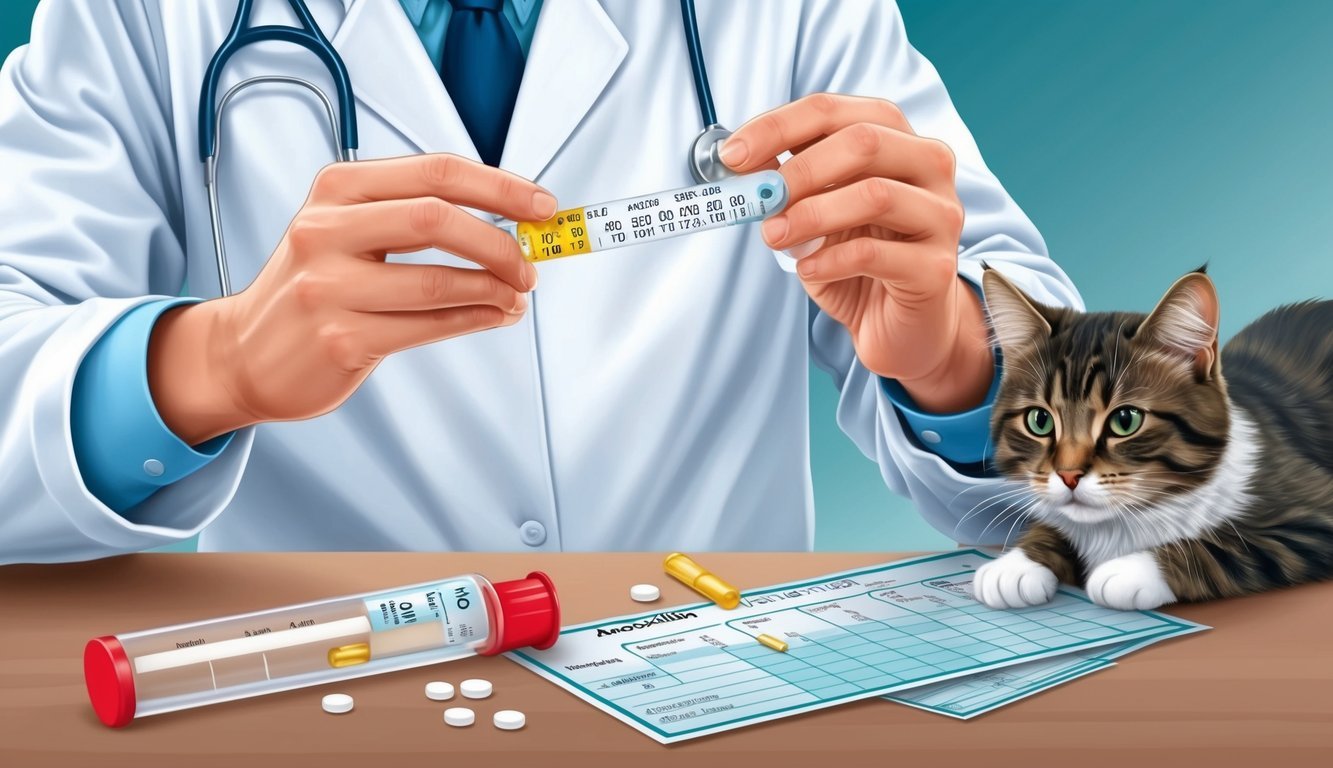
When administering antibiotics to your cat, selecting the appropriate medication and understanding the implications of antibiotic resistance are crucial.
These factors ensure not only the effectiveness of the treatment but also the long-term health of your pet.
Choosing the Right Antibiotic
Selecting the right antibiotic for your cat is vital.
While human amoxicillin is sometimes used, it’s important to understand that formulation differences exist.
Veterinary amoxicillin is specifically designed for cats and takes into account their unique physiology.
If your cat has a penicillin allergy, you should avoid amoxicillin altogether.
Clavamox, a combination antibiotic, may be prescribed as an alternative due to its broader spectrum of action.
Always consult with your veterinarian to determine the most appropriate choice for your cat’s condition.
They can provide Amoxi-Drop or other specific formulations that ensure safe and effective treatment.
Understanding Antibiotic Resistance
Antibiotic resistance is a significant concern in veterinary medicine.
Overuse of antibiotics can lead to resistant strains of bacteria.
When this happens, standard treatments may no longer be effective, prolonging your cat’s illness.
Make sure to follow the prescribed dosage and duration exactly as instructed.
If your veterinarian prescribes a course of amoxicillin, complete it even if your cat appears to improve before finishing the medication.
This helps prevent the emergence of resistant bacteria and ensures your furry friend fully recovers.
If you have any doubts or observe side effects, contact your veterinarian promptly.
Case Studies: Amoxicillin Success Stories
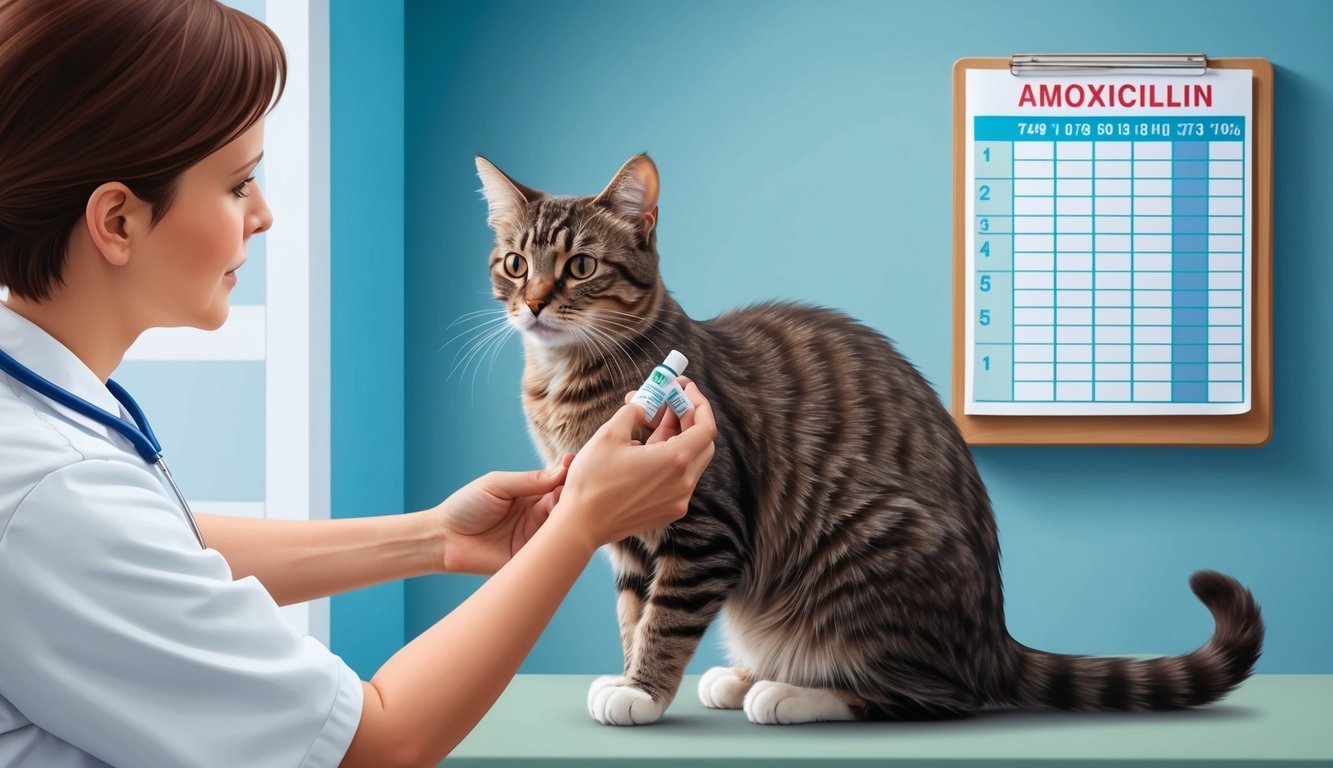
Amoxicillin has proven to be a valuable treatment for various bacterial infections in cats.
From resolving urinary tract infections to addressing skin and dental issues, many pet owners have witnessed significant improvements in their feline companions.
Resolving Urinary Tract Infections
Urinary tract infections (UTIs) can be painful for your cat.
A notable case involved a cat named Whiskers who displayed discomfort while urinating and frequent trips to the litter box.
The veterinarian prescribed amoxicillin at a dosage of 5-10 mg per pound.
After a week of treatment, Whiskers showed marked improvement.
The frequency of trips to the litter box decreased, and normal behavior returned.
Following the course, a follow-up visit confirmed the infection had cleared.
This illustrates how effective amoxicillin can be for treating bladder infections, bringing relief and comfort to your pet.
Treating Skin and Dental Issues
Many cats can develop skin issues, such as abscesses.
Take the case of Bella, who developed an abscess from a scratch.
The vet recommended amoxicillin to combat the infection.
They also instructed Bella’s owner to administer it at 5 mg per pound once daily.
After 10 days, Bella’s wound began to heal, and signs of infection subsided.
Similarly, for dental infections, amoxicillin helped a cat named Max who had been experiencing pain and swelling around his gums.
With appropriate dosage and a full treatment course, both cats returned to their playful selves.
These cases highlight how amoxicillin can assist in recovering from skin and dental infections, enhancing your cat’s overall health.
Advisory on Missed Doses and Overdosing

Administering amoxicillin to your cat requires careful attention to avoid missed doses and potential overdosing.
Knowing how to handle these situations can help keep your cat safe and healthy.
What to Do If You Miss a Dose
If you miss a dose of amoxicillin for your cat, take it as soon as you remember.
If it’s almost time for the next dose, skip the missed one and continue with your regular schedule.
Never double up to make up for a missed dose.
Important Points:
- Timing: Administer the dose within 2-3 hours of the scheduled time.
- Consult Your Veterinarian: If you frequently miss doses or are unsure about what to do, it’s best to consult your veterinarian. They can provide tailored advice for your cat’s specific needs.
Maintaining a consistent routine can help prevent missed doses in the first place.
Consider using a reminder app or setting alarms to help you remember when it’s time to give your cat their medication.
Risks of Overdosage in Cats
Overdosing your cat with amoxicillin can lead to serious health issues.
Symptoms of an overdose may include vomiting, diarrhea, lethargy, or seizures.
If you suspect your cat has received too much medication, contact your veterinarian immediately.
Signs to Watch For:
- Gastrointestinal Issues: Vomiting or diarrhea.
- Neurological Symptoms: Tremors or seizures.
To help prevent overdosing, always follow the prescribed dosage guidelines from your veterinarian.
Human amoxicillin is not formulated for cats, and dosages can vary significantly between species.
Before administering any medication, ensure that you’re clear on the correct dosage for your cat’s weight and health condition.
If in doubt, always reach out to your vet for clarification.
Proactive Measures and Preventative Care
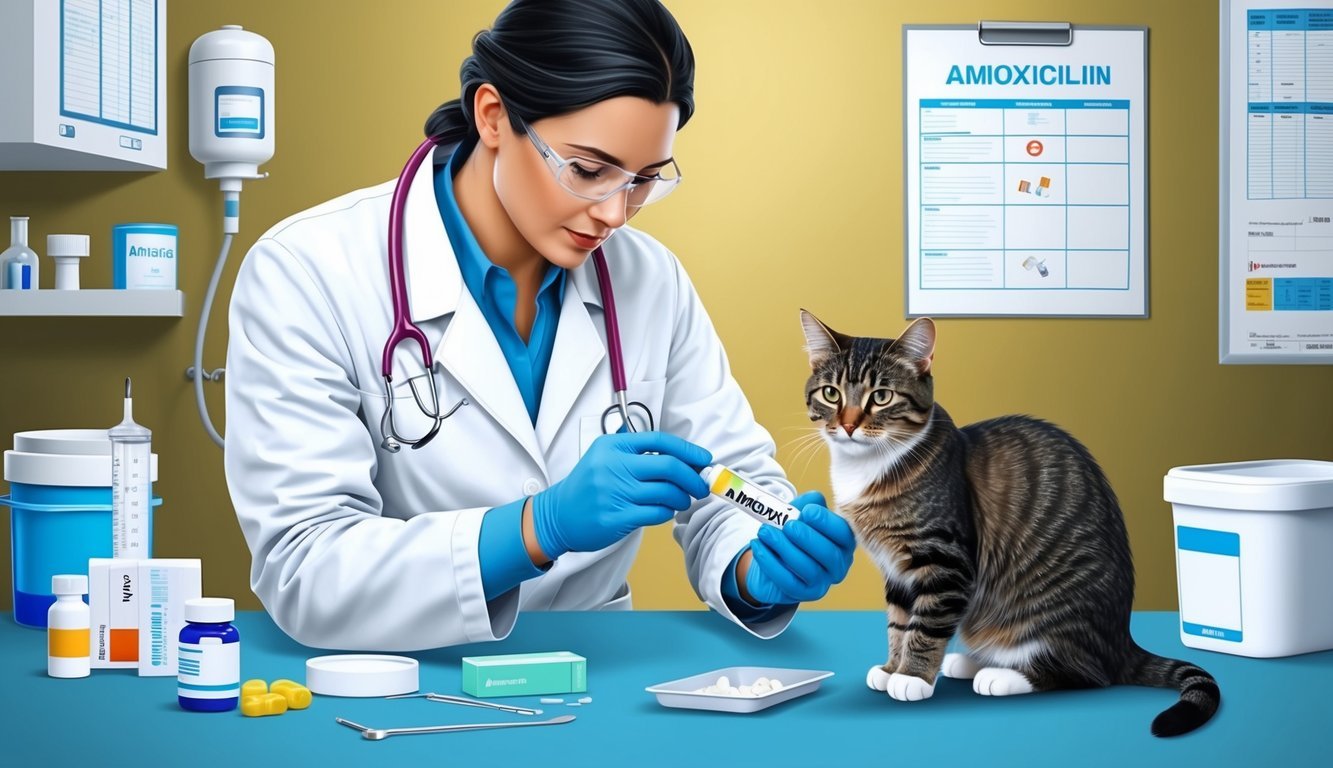
Maintaining feline health through proactive measures is crucial for your cat’s well-being.
Regular check-ups with veterinarians and holistic approaches are essential components of a comprehensive care plan.
Regular Veterinary Check-Ups
Regular visits to the veterinarian are vital.
These check-ups help monitor your cat’s overall health, identify potential issues early, and ensure vaccinations are up to date.
What to Expect:
- Physical Exam: Your vet will conduct a thorough physical assessment, checking for any signs of illness or digestive upset.
- Vaccinations: Ensure your cat receives necessary vaccinations based on age and health status.
- Laboratory Tests: Blood tests or fecal exams may be recommended to screen for parasites and other health concerns.
Plan for annual visits or more frequent check-ups for senior cats or those with existing health issues.
Holistic Approaches to Feline Health
Maintaining feline health through proactive measures is crucial for your cat’s well-being.
Regular check-ups with veterinarians and holistic approaches are essential components of a comprehensive care plan.
Regular Veterinary Check-Ups
Regular visits to the veterinarian are vital.
These check-ups help monitor your cat’s overall health, identify potential issues early, and ensure vaccinations are up to date.
What to Expect:
- Physical Exam: Your vet will conduct a thorough physical assessment, checking for any signs of illness or digestive upset.
- Vaccinations: Ensure your cat receives necessary vaccinations based on age and health status.
- Laboratory Tests: Blood tests or fecal exams may be recommended to screen for parasites and other health concerns.
Plan for annual visits or more frequent check-ups for senior cats or those with existing health issues.
Holistic Approaches to Feline Health
Incorporating holistic methods can complement traditional veterinary care.
These approaches might include dietary adjustments, natural supplements, and environmental enrichment.
Consider the Following:
- Nutrition: Feed a balanced diet with high-quality ingredients. This can improve vitality and digestive health.
- Supplements: Consult your veterinarian about beneficial supplements, such as probiotics for digestive support or omega-3 fatty acids for skin health.
- Mental and Physical Stimulation: Engage your cat with toys and interactive play. This can reduce stress and prevent behavioral problems.
Combining these holistic strategies with professional veterinary care can lead to a healthier, happier cat.
Frequently Asked Questions

Here are some important questions about Amoxicillin dosage for cats.
Understanding these will help you make informed decisions regarding your pet’s treatment.
What is the recommended dosage of Amoxicillin 250 mg for a cat?
The typical recommended dosage for cats is between 5 to 10 mg per pound of body weight.
For a cat weighing 10 pounds, this would translate to a dose of 50 to 100 mg.
Always consult your veterinarian for the correct dosage specific to your cat’s health condition.
How do you calculate the correct dose of Amoxicillin for a cat based on their weight?
To calculate the dose, you multiply your cat’s weight in pounds by the recommended dosage of 5 to 10 mg.
For instance, a 10-pound cat would need a dose between 50 mg and 100 mg.
It’s essential to consult a veterinarian for precise calculations tailored to your cat’s needs.
Can I give my cat Amoxicillin that is prescribed for humans, and what is the proper dosage?
You should not administer human Amoxicillin to your cat without veterinary guidance.
The dosage and formulation are different, which can lead to serious side effects.
Always use a veterinarian-prescribed formulation specifically designed for cats.
For how many days should a typical Amoxicillin course last when treating a cat?
A typical course of Amoxicillin can last from 7 to 14 days, depending on the infection being treated.
Your veterinarian will determine the exact duration based on your cat’s specific condition and response to the medication.
What is the safe dosage of Amoxicillin in mL for a cat per day?
The safe dosage of Amoxicillin in liquid form typically ranges from 2 to 9 mL per pound of body weight, administered every 12 to 24 hours.
The exact amount can vary based on your cat’s needs and should be directed by your veterinarian.
Where can I find a dosage chart for administering Amoxicillin to cats?
You can find dosage charts in veterinary resources, online veterinary medical sites, or by asking your veterinarian directly.
Your veterinarian can provide the most accurate and tailored information to ensure safe administration of the medication to your cat.

